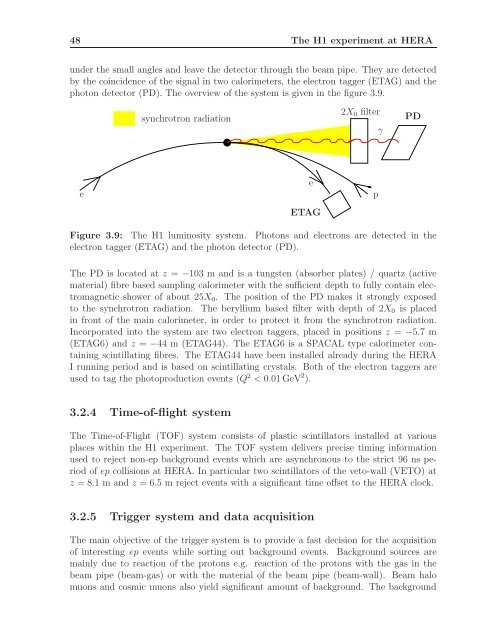10 - H1 - Desy
10 - H1 - Desy
10 - H1 - Desy
You also want an ePaper? Increase the reach of your titles
YUMPU automatically turns print PDFs into web optimized ePapers that Google loves.
48 The <strong>H1</strong> experiment at HERA<br />
under the small angles and leave the detector through the beam pipe. They are detected<br />
by the coincidence of the signal in two calorimeters, the electron tagger (ETAG) and the<br />
photon detector (PD). The overview of the system is given in the figure 3.9.<br />
synchrotron radiation<br />
2X 0 filter<br />
γ<br />
PD<br />
e<br />
e<br />
ETAG<br />
p<br />
Figure 3.9: The <strong>H1</strong> luminosity system. Photons and electrons are detected in the<br />
electron tagger (ETAG) and the photon detector (PD).<br />
The PD is located at z = −<strong>10</strong>3 m and is a tungsten (absorber plates) / quartz (active<br />
material) fibre based sampling calorimeter with the sufficient depth to fully contain electromagnetic<br />
shower of about 25X 0 . The position of the PD makes it strongly exposed<br />
to the synchrotron radiation. The beryllium based filter with depth of 2X 0 is placed<br />
in front of the main calorimeter, in order to protect it from the synchrotron radiation.<br />
Incorporated into the system are two electron taggers, placed in positions z = −5.7 m<br />
(ETAG6) and z = −44 m (ETAG44). The ETAG6 is a SPACAL type calorimeter containing<br />
scintillating fibres. The ETAG44 have been installed already during the HERA<br />
I running period and is based on scintillating crystals. Both of the electron taggers are<br />
used to tag the photoproduction events (Q 2 < 0.01 GeV 2 ).<br />
3.2.4 Time-of-flight system<br />
The Time-of-Flight (TOF) system consists of plastic scintillators installed at various<br />
places within the <strong>H1</strong> experiment. The TOF system delivers precise timing information<br />
used to reject non-ep background events which are asynchronous to the strict 96 ns period<br />
of ep collisions at HERA. In particular two scintillators of the veto-wall (VETO) at<br />
z = 8.1 m and z = 6.5 m reject events with a significant time offset to the HERA clock.<br />
3.2.5 Trigger system and data acquisition<br />
The main objective of the trigger system is to provide a fast decision for the acquisition<br />
of interesting ep events while sorting out background events. Background sources are<br />
mainly due to reaction of the protons e.g. reaction of the protons with the gas in the<br />
beam pipe (beam-gas) or with the material of the beam pipe (beam-wall). Beam halo<br />
muons and cosmic muons also yield significant amount of background. The background
















